Physical Address
304 North Cardinal St.
Dorchester Center, MA 02124
The rate of change in the appearances of the developing fetal brain is quite remarkable and ultrasound has undoubtledly opened a new window into developing embryology. However it is important to realize that normality of the brain can only be determined if the gestational age is accurately known, and with knowledge and appreciation of the evolution and development of the human brain. It is through understanding human embryology that we recognize with ultrasound any deviations from normal anatomy that may occur.
The basic embryology will be described below ( Table 11-1 ); however in addition, development of the prominent structures within each of the essential planes will be described in more detail later. It is the timing of the scan that is vital when attempting a firm diagnosis with ultrasound; it is important to know when a particular anatomical structure should always be recognizable on scan rather than the earliest documented sighting, i.e. the concept of the threshold versus the discriminatory level for exclusion of an abnormality. For example, the cerebellar vermis does not fully form until 19 weeks' gestation and therefore exclusion of inferior vermian agenesis, an important diagnosis prognostically, may not be made with confidence until this time.
| Week 5 |
|
|
| Week 6 | Neural groove folds to form a tube ( Figure 11-1 ) | |
|
|
|
|
||
| Insults at this stage result in anencephaly | Insults at this stage result in neural tube defects | |
| Week 7 | Prosencephalon divides into the telencephalon and diencephalon ( Figure 11-2 ): | |
|
|
|
| Mesencephalon forms the midbrain and the accompanying aqueduct of Sylvius. | ||
| Rhombencephalon divides into the metencephalon and myelencephalon: | ||
|
|
|
| During this week the eyes, nasal pits and mouth begin to develop. | ||
| Insults at this stage result in abnormalities of midline development such as agenesis of the corpus callosum and holoprosencephaly | ||
| Week 8–Term | By this stage, differentiation has occurred to form the basic template of the structure of the brain; thereafter there is further growth and development. | |
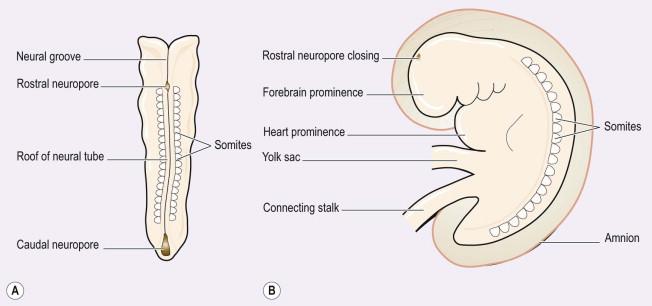

The brain may be divided into supratentorial structures (cerebral hemispheres, ventricular system and midline structures) and infratentorial structures (cerebellar hemispheres, vermis and fourth ventricle), and achieving a diagnosis of abnormality requires the sonographer not only to detect that there is an abnormality present, but to also to define which parts of the brain are involved.
There are two components to the assessment of the brain by ultrasound:
The first is to confirm that early embryological development has proceeded normally. This is based on the assumption that normal brain shape indicates normal brain structure and development.
The second is to be familiar with the changes in the brain that occur with advancing gestational age and how these impact upon the ultrasound image.
There are three axial image planes through the fetal brain that allow for an effective screen for normality. Studies show that 95% of all central nervous system abnormalities may be detected using this approach.
The transthalamic view ( Figure 11-3 A) is that initially used for measuring the head circumference and the biparietal diameter ( Figure 11-4 ).
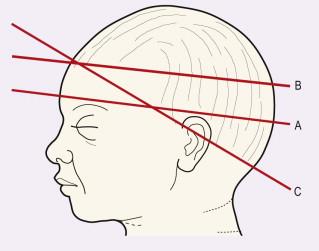
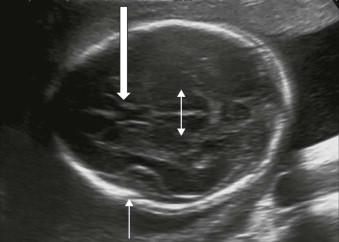
The transventricular view ( Figure 11-3 B) is obtained superior and parallel to plane (A) at the level of the ventricular atrium ( Figure 11-5 ).
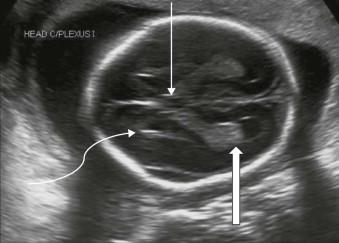
The transcerebellar view ( Figure 11-3 C) is inclined inferiorly through the posterior fossa ( Figure 11-6 ).
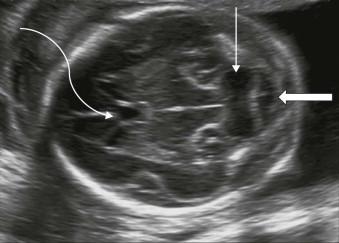
Each plane of assessment will be described with respect to the anatomical landmarks and the structures that can be assessed within this plane.
Transthalamic plane ( Figures 11-3 and 11-4 ): the landmarks for this plane are:
Cavum septum pellucidum (CSP) which is a small anechoic rectangular box situated in the midline at the junction of the anterior and middle one-thirds. It is very important to note that there are no echoes within the CSP and it does not have a well-defined anterior and posterior border.
Posterior to the CSP are the paired hypo-echoic thalamic nuclei separated by the slit-like 3rd ventricle (this is normally less than 2 mm in size).
The Sylvian fissure is an indentation on the outer surface of the cerebral hemisphere whose size and shape varies with advancing gestational age.
Anatomical structures assessed on this section:
Midline prosencephalon.
The corpus callosum is a bundle of fibres that connects the two cerebral hemispheres across the midline. It comprises four sections that develop from 7 weeks' gestation beginning with the most anterior portion called the genu. The body and splenium subsequently and sequentially develop, with the rostrum (continuous with the genu extending inferiorly and then posteriorly) being the last section to develop. The corpus callosum has formed in its entirety by 20 weeks after which gestation diagnosis of abnormalities can be achieved with accuracy. Insults during development that occur prior to 12 weeks result in complete agenesis, with partial agenesis (dysgenesis) after this gestation. The development of the cavum septum pellucidum and the corpus callosum are intimately related; if the corpus callosum is not present then the cavum septum pellucidum will not have formed, however the converse is not true, the CSP can be absent in the presence of an intact corpus callosum ( Figure 11-7 ).
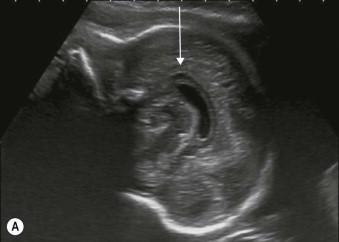
Supratentorial ventricular system.
Cerebral hemispheres.
Head size, shape and cranial vault ossification.
Pitfalls and normal variants of this plane:
The fornices of the hypothalamus will also appear as a box-like midline structure just below the level of the CSP. The fornices will always have a midline echo through the centre of the box ( Figure 11-8 ).
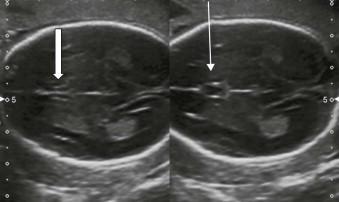
The cavum septum vergae is a recognized normal variant and it is simply a posterior extension of the cavum septum pellucidum. It is not an abnormality ( Figure 11-9 ).
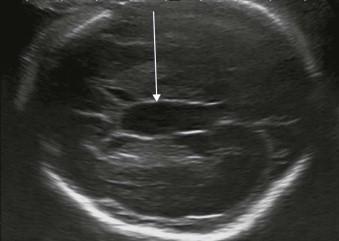
Transventricular plane ( Figures 11-3 and 11-5 ): this plane is parallel and superior to the transthalamic plane and the landmarks for this plane are:
Choroid plexus within the lateral ventricle particularly within the atrium of the lateral ventricle ( Figure 11-5 ).
Hypo-echoic featureless cerebral hemispheres, with the lateral sulcus or the Sylvian fissure the only real infolding seen at the time of the fetal anomaly scan at 18 to 22 weeks ( Figures 11-5 and 11-6 ).
Anatomical structures assessed on this section:
Supratentorial ventricular system.
The ventricular atrium is stable in size throughout gestation from 15 weeks to term, with a mean measurement first reported as 7.6 mm ± 0.6 mm SDs, giving a measurement of 10 mm as +4 SD above the mean ( Figure 11-10 ). Ventriculomegaly is diagnosed when the atrium measures 10 mm and above. Ventricular symmetry is assumed in the routine assessment of the atria using the ventricular atrial measurement. The cerebral hemispheres should be symmetrical in thickness and shape. In the late first/early second trimester (before 16 weeks), the dominant features on images of the cerebral hemispheres are the highly echogenic choroid plexi which fill each of the lateral ventricles. The third ventricle becomes more readily visible, defined laterally by its walls, which are echogenic, linear and separated by 1–2 mm.
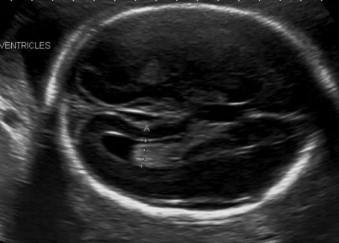
Cerebral hemispheres.
The cerebral hemispheres are themselves featureless and hypo-echoic with both ventricular and arachnoid surfaces being indistinct, unless the surfaces are perpendicular to the ultrasound beam when they produce a strong specular echo. By mid-second trimester (18–20 weeks), folding (sulcation) of the cerebral hemispheres begins with the definition of the lateral sulcus or Sylvian fissure ( Figure 11-5 ): this is first seen as a rectangular-shaped indentation on the surface of the brain. As the pregnancy progresses the cerebral tissue becomes less hypo-echoic and there is greater clarity of the cerebral borders with the ventricular walls becoming more clearly defined and the arachnoid surface distinct. From 20 weeks onwards there is a well-recognized rate of appearance of the sulci and the fissures of the brain, sulci are first seen as little notches of the brain surface which become more well-defined infoldings with age ( Figure 11-11 ; Table 11-2 ).
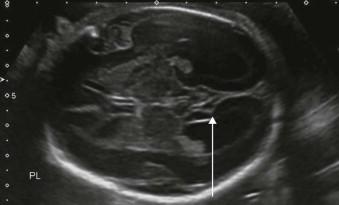
| Ultrasound | MRI | |||
|---|---|---|---|---|
| Structure | 1st Seen: Gestational Age in Weeks |
Always Seen: Gestational Age in Weeks |
1st Seen: Gestational Age in Weeks |
Always Seen: Gestational Age in Weeks |
| Parieto-occipital fissure | 18.5 | 20.5 | 18–19 | 22–23 |
| Calcarine fissure | 18.5 | 21.9 | 18–19 | 22–23 |
| Cingulate sulcus | 23.2 | 24.3 | 24–25 | 28–29 |
| Convexity sulci | 23.2 | 27.9 | 26–27 | 28–29 |
| Central sulcus | 26–27 | 26–27 | ||
Head size, shape and cranial vault ossification.
The fetal head is essentially elliptical (occasionally rounded) being broader posteriorly and symmetric without irregularity of contour. Ossification of the skull vault is complete by 12 weeks' gestation with the sutures remaining visible throughout pregnancy. The skin overlying the vault is thin, measuring 1 to 2 mm thickness, increasing slightly posteriorly (nuchal thickness) to a maximum that varies with gestational age.
The landmarks for this plane are ( Figures 11-3 and 11-6 ):
Cerebellar hemispheres.
Superior vermis.
Cisterna magna.
Cavum septum pellucidum.
If this plane is assessed by over-angling inferiorly then a cleft in the inferior vermis may be seen simulating an inferior vermian problem, the cisterna magna will measure more than the normal 10 mm and a mega cisterna magna is diagnosed.
Anatomical structures assessed on this section:
Midline prosencephalon.
Posterior fossa anatomy.
The cerebellum consists of paired, round hemispheres connected by an echogenic midline bridge, the vermis, which has two discrete components: the superior and the inferior vermis. The cisterna magna lies posterior to the vermis and is crescentic in shape. It is measured in the midline from the posterior aspect of the vermis to the internal surface of the occipital bone, and should measure between 4 and 10 mm ( Figure 11-6 ). The posterior fossa structures can be reliably imaged in 90% of fetuses between 15 and 25 weeks' gestation. In the midline within the cisterna magna, several fine echogenic lines may be observed in 92% of scans between 15 and 38 weeks' gestation. These are thought to represent arachnoid septae and are not of pathological significance ( Figure 11-12 ).
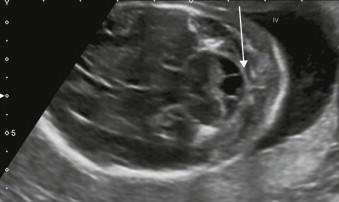
The cerebellar hemispheres are recognized on ultrasound as discrete structures from 12 to 13 weeks' gestation with the vermis recognizable approximately 1 week later. The cerebellum changes in size and appearance with advancing gestational age. Initially, the hemispheres are hypo-echoic with echogenic margins but, with increasing development of the folds of the surface (known as folia), they become increasingly echogenic with a characteristic appearance by the late second trimester. Formation of the vermis itself is not complete until 19 weeks and it is consistently echogenic on ultrasound. The fourth ventricle is a fluid-filled, triangular structure, sited anterior to the vermis in the midline. The vermis always interposes between it and the cisterna magna from 19 weeks when vermian development is complete ( Figure 11-13 A and B ). The cerebellum is sometimes more elegantly demonstrated even between 21 and 39 weeks' gestation by transvaginal (TV) ultrasound. There are normal values for all dimensions of the vermis and normal values for the transcerebellar diameter also.
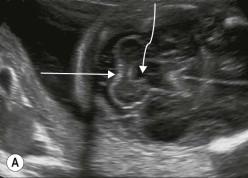
The introduction of high-resolution probes, a greater understanding of the normal embryology and a recognition that the assessment of the neonatal cranial anatomy through the still-open fontanelles could be applied to the developing fetus has resulted in the concept of the fetal neurosonogram.
The views of the fetal neurosongoram can, with practice and skill, be obtained enabling the fetal brain to be imaged in a variety of additional planes. There are at least seven additional views as defined by the term neurosonography: three sagittal planes and four to five coronal planes. These planes are assessed through the anterior fontanelle and the technique is a well-recognized sweep from side to side in the sagittal plane and from front to back in the coronal plane.
A pictorial review of these planes is the best way to illustrate the technique and the structures that can be evaluated at each plane ( Figures 11-14 to 11-21 ).
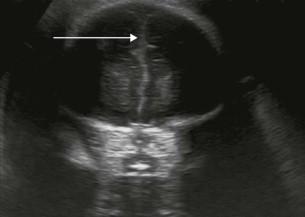
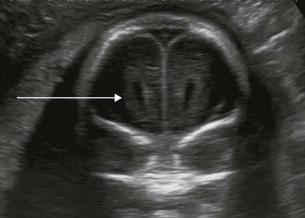
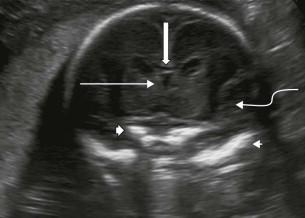
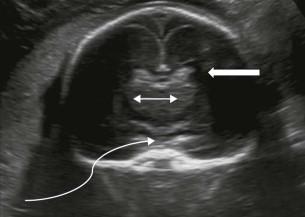

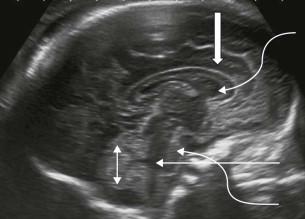
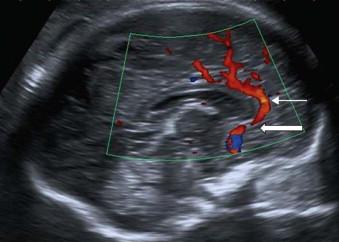
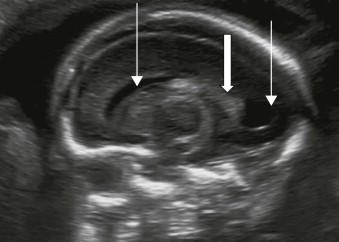
In the assessment of any central nervous system abnormality there are a few general principles that are important in helping to establish the prognosis and hence help the parents to reach a decision regarding management.
The entire brain must be carefully examined to establish how many abnormalities are present; remember that midline abnormalities such as Dandy–Walker malformation and agenesis of the corpus callosum often go together.
The entire fetus must be carefully examined to search for any associated abnormalities in other body systems.
It may be appropriate to consider invasive testing to detemine fetal karyotype as the risk of aneuploidy is increased if there are multiple systems involved, or if certain central nervous system abnormalities, such as Dandy–Walker malformation, holoprosencephaly and encephalocoele are diagnosed.
Anencephaly and exencephaly sequence.
Abnormalities of head size.
Abnormalities of head shape.
Anencephaly is the most severe form of neural tube defect which results from failure of closure of the rostral neuropore (see Embryology , above) and is recognized by failure of development of the skull vault. This defect was traditionally diagnosed at the anatomy scan when the bones of the cranium were found to be deficient above the level of the orbits. The characteristic sonographic feature at this stage is the so-called ‘frog's face’ appearance which is due to complete lack of bone and brain above the level of the orbits, with the eye sockets appearing enlarged ( Figure 11-22 ). With the widespread introduction of the 11 to 13 week scan, most cases of anencephaly are diagnosed at this stage of gestation.
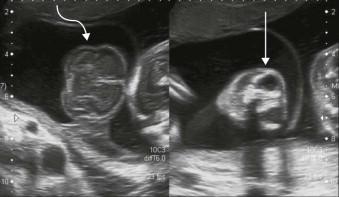
The incidence according to EUROCAT data is 3.75 per 10,000 births which is undoubtedly decreasing due to prenatal diagnosis and termination of pregnancy.
It is believed that anencephaly is the end stage of a sequence of events that begins with lack of the skull vault (‘acrania’) with exposure of the delicate fetal brain to the amniotic fluid. The exposed brain which may be referred to as the angiomatous stroma is initially quite normal in appearance ( Figure 11-23 ). The bulging of the brain above the orbits produces ‘the Mickey Mouse face’ sign which now allows for diagnosis of this lethal defect in the first trimester ( Figure 11-24 ); this phase is the exencephaly phase. Finally, due to destruction of the cerebral hemispheres, the typical anencephaly stage is then reached ( Figure 11-22 ).
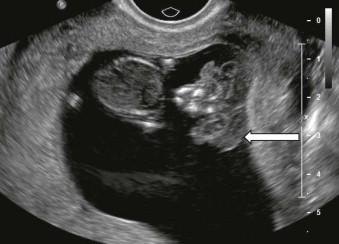
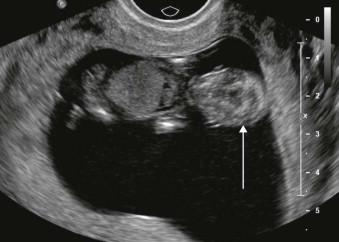
At the exencephalic stage of the sequence the defect may resemble a large posterior encephalocoele; however with an encephalocoele there will always be some normal cranial bone visible which is obviously not the case with anencephaly ( Figure 11-25 A and B ).

The amniotic band syndrome may actually produce anencephaly, but the true nature of the aetiology will be evident when the additional defects of this syndrome such as limb amputation, spinal anomalies – especially scoliosis, and large abdominal wall defects are seen.
Additonal defects are seen in 25–50% of cases and these tend to be neural tube defects such as spina bifida, iniencephaly and craniorachischisis; however cleft lip/palate, omphalocoele, congenital heart disease and limb anomalies have also been described. From the literature it is difficult to ascertain how many of these reported associated anomalies were not part of an original amniotic band syndrome! If the anencephaly is isolated, then the risk of an underlying chromosomal defect is considered to be very low, but any additional defects on ultrasound will increase this risk to 11%.
As this is a lethal anomaly, termination of pregnancy can be considered as an option. In fact, only a few cases survive more than a week after birth.
An encephalocoele is also characterized by a defect in the skull and dura through which the meninges herniate with or without skin covering. Encephalocoeles may be classified according to their location, i.e. the bone of the brain affected.
Midline occipital, 85% of cases.
Eccentric parietal, 15% of cases.
Frontal (very rare).
The encephalocoele may also be classified according to the contents of the meningeal sac: a cranial meningocoele contains only meninges whereas a true encephalocoele contains brain tissue ( Figure 11-26 A and B ). The Chiari III malformation is the term for an encephalocoele which contains the cerebellum.
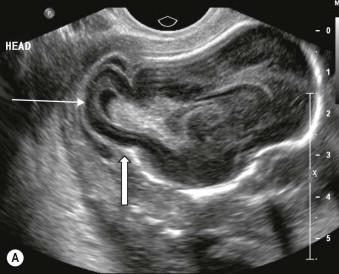
Sonographically a sac containing either fluid or herniated brain is seen along with the underlying cranial vault abnormality in 80% of cases. There is considerable variation in the size of these defects and some small lesions may be missed altogether ( Figure 11-27 ). In addition the appearance will change throughout gestation with gradual destruction of the extruded brain to produce a picture very like anencephaly, but there will always be visible bone above the orbits ( Figure 11-28 ). As with anencephaly the amniotic band syndrome may actually produce an encephalocoele ( Figure 11-29 ).
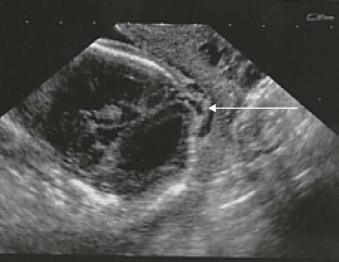
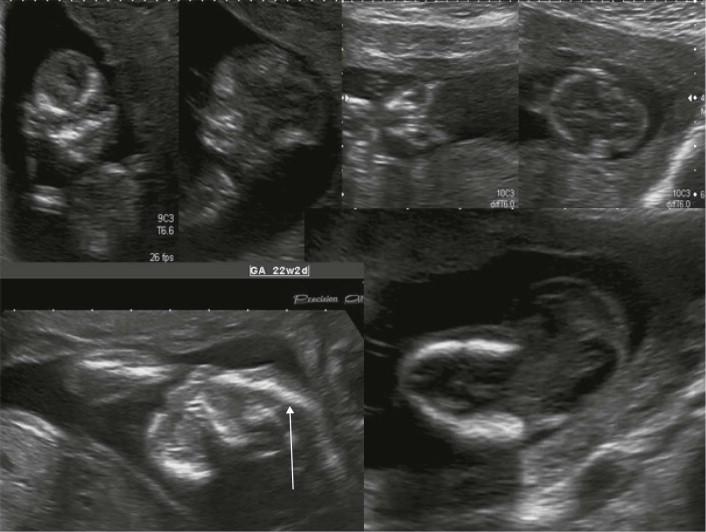
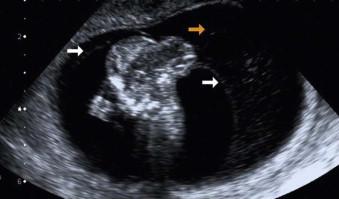
In the presence of an encephalocoele there is a risk of an associated cerebral and extracerebral abnormality in 60–80% of cases. Encephalocoeles may be one component of a genetic syndrome or condition of which the most common are Meckel–Gruber syndrome and Walker–Warburg syndrome. It is important to recognize these syndromes as many are autosomal recessive conditions with a risk of recurrence of 1 in 4, and as they can be recognized on ultrasound, there is the opportunity to offer earlier targeted screening in subsequent pregnancies. The literature suggests a 13–44% risk of chromosomal abnormality, in particularly trisomy 13 and 18, and therefore karyotyping should be discussed and offered.
Prognosis, and hence management, will depend on the site, size and content of the encephalocoele, the karyotype, associated abnormalities and ease of surgical reduction and repair. Should the chromosomes be abnormal, this will be the determining prognostic factor. If there are associated abnormalities, clinical geneticists should be consulted for their advice as to the likelihood of a syndrome unifying the scan features that will allow a prognosis and risk of recurrence to be ascertained.
Good prognostic indicators are defects that are anterior, contain no brain, and have no other anomalies identified. Poor prognostic features on scan are encephalocoeles that are posterior and large, or those that contain brain and are associated with other system anomalies. Prenatal series report low survival rates of 21%, with significant developmental delay in the survivors, compared with an overall survival rate in a postnatal series of 71%.
Further abnormalities of the cranial vault detectable on the transthalamic and the supraventricular planes are now described.
The diagnosis of a small head is based on a head circumference below the 3rd centile for gestational age, as established ideally by early scan biometry or by last menstrual period date.
Microcephaly is found in any condition that retards normal brain growth; these conditions may be due to:
Underlying structural brain abnormalities such as holoprosencephaly, abnormalities of sulcation or neuronal migration defects ( Figure 11-30 A and B ). These abnormalities may have a multifactorial aetiology, i.e. they may be chromosomal, genetic or due to inherited syndromes.
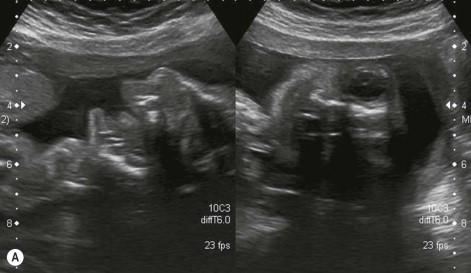
Acquired brain defects due to infection, ischaemia and other vascular disruptive events, and teratogens.
Microcephaly may become apparent early in the second trimester and this in my experience is the case with holoprosencephaly and an encephalocoele for example, but it is more usually diagnosed within the third trimester (this type of microcephaly usually being secondary to some disruptive event).
Become a Clinical Tree membership for Full access and enjoy Unlimited articles
If you are a member. Log in here